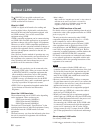
Appendix 93
Appendix
Main differences between HDV1080i, DVCAM, and DV Formats
(The unit and other equipment for professional use may be functionally extended. For details, see the notes below
the table.)
1) There are two modes for audio signals recording: Lock mode and Unlock mode. In Lock mode, the sampling frequencies of
audio and video are synchronized. In Unlock mode, adopted by the consumer DV format, the two sampling frequencies are
independent. Lock mode maintains high compatibility with higher formats and offers better digital processing and smooth
transition than Unlock mode when you edit audio.
2) The unit cannot record in DV format with 16 bit:32 kHz or 44.1 kHz.
3) The unit has been functionally extended with a function for switching between Lock mode and Unlock mode.
4) The unit has been functionally extended with a function to enable selecting DF/NDF and user bits setting for 60i with HDV
or DV (SP) format.
Appendix
Compatibility of HDV, DVCAM, and DV Formats
HDV format is an HD VCR format based on DV format of the globally widespread general consumer digital VCR
system. This format has the newly defined data recording specifications for HD signals compressed by MPEG2. It
applies the same cassette, tape speed, and track pitch as DV format.
The differences, compatibility, and restrictions in editing of HDV1080i, DVCAM, and DV formats are explained
below.
10 µm
12 bit: 32 kHz
16 bit: 32 kHz, 44.1 kHz, 48 kHz
2)
Unlock mode
3)
Drop frame mode
(NTSC only)
4)
No user bits
4)
Specification HDV1080i DVCAM DV (SP)
10 µm
16 bit: 48 kHz
Lock mode
Drop frame mode
(60i only)
4)
No user bits
4)
15 µm
12 bit: 32 kHz
16 bit: 48 kHz
Lock mode
NTSC: SMPTE time code
(DF/NDF, including user bits)
PAL: EBU time code
(including user bits)
Track pitch
Audio sampling frequency
Audio recording mode
1)
Time code


















